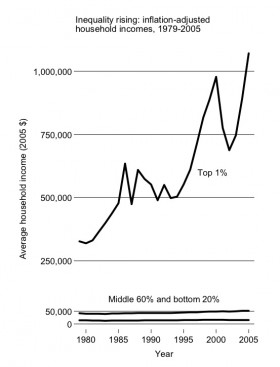Michael Pollan spoke to Newsweek about the new documentary on our industrial food system Food, Inc. In his comments, he made some crucial points about differences between US and Europe that go beyond “food culture”:
[T]hey have a better safety net [in Europe]. You can afford to spend 15 to 17 percent of your income on food if you don’t have to worry about healthcare, if you know you’re going to get, I don’t know, five weeks of vacation a year and your retirement is not in doubt. So one of the reasons we’re so dependent on cheap food is we have a society that makes it hard to afford anything else.
Amen! Yes, health care reform is fundamental to food system reform, for both farmers and eaters. But there’s even more to the European welfare state than health benefits, vacations and pensions.  Graph: Lane KenworthyThere’s wages. Many European countries have national wage accords that are set in consultation with workers, management AND government that guarantee fair wage growth for everyone. In fact, unionization rates in Europe on their own don’t determine wage growth — but these national wage accords do. We in the US have nothing like that, of course. And our super-low unionization rates don’t help. Instead, we have massive income inequality.
Graph: Lane KenworthyThere’s wages. Many European countries have national wage accords that are set in consultation with workers, management AND government that guarantee fair wage growth for everyone. In fact, unionization rates in Europe on their own don’t determine wage growth — but these national wage accords do. We in the US have nothing like that, of course. And our super-low unionization rates don’t help. Instead, we have massive income inequality.
Those two lines pinned at the bottom of the graph at left show inflation-adjusted wage growth for the middle 60% and bottom 20% of earners — that would be most people. Totally flat for the last 25 years. The top 1% of earners got all the growth. Thus when you look at the chart below that shows the inflation-adjusted change in the prices of different foods, is it any surprise that processed food and CAFO meat have won the day (at the moment anyway)? Over the last 30 years, most Americans got their raises in the form of cheap soda, chips and fast food. That’s a pretty neat trick, huh?
But it’s worse than that. The European wage and benefits structure gave people something as important as money.  Graph: The New York TimesIt gave them time — Europeans haven’t been forced to hold down two jobs to make ends meet. And when it comes to eating real food, time is the ultimate luxury. It’s not a mystery how to eat healthy food inexpensively. It’s just that Americans can’t afford to spend an hour cooking beans or preparing stews (that often feature inexpensive cuts of meat and thus don’t require CAFOs to supply cheap steaks). For many Americans, the time it takes to shop for, prepare, eat, and clean up after even a quick vegetable stir-fry may be too much..
Graph: The New York TimesIt gave them time — Europeans haven’t been forced to hold down two jobs to make ends meet. And when it comes to eating real food, time is the ultimate luxury. It’s not a mystery how to eat healthy food inexpensively. It’s just that Americans can’t afford to spend an hour cooking beans or preparing stews (that often feature inexpensive cuts of meat and thus don’t require CAFOs to supply cheap steaks). For many Americans, the time it takes to shop for, prepare, eat, and clean up after even a quick vegetable stir-fry may be too much..
That, as Pollan identifies, is the challenge before us. Living in a society that punishes middle- and low-income folks with little in the way of rising incomes or time, and forces most of us to spend as little as possible on food, makes fixing a food system that’s slowly killing many of us even harder. This challenge is why, as Pollan says in his interview, “it’s not enough to vote with your fork.” After all, time and money don’t grow on trees. To paraphrase Al Gore, change your food, but change your government, too.



